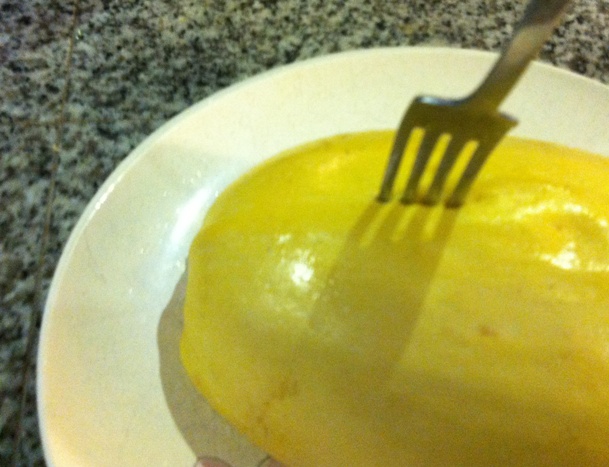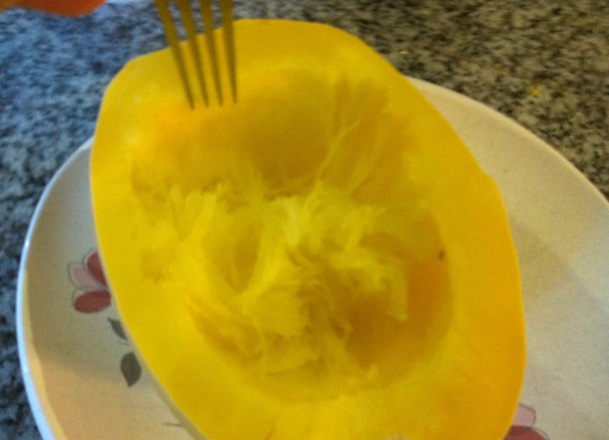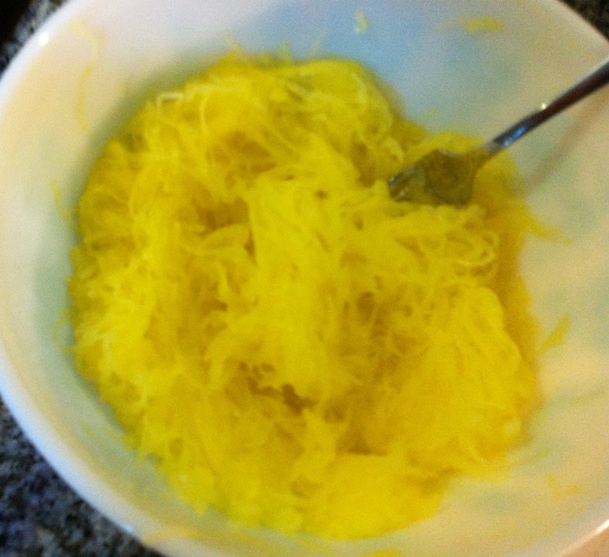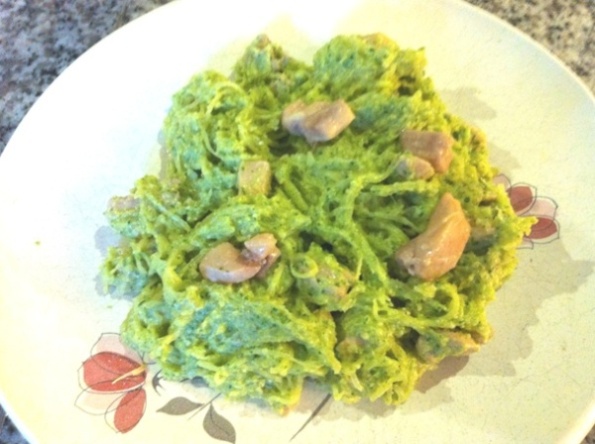If you are like me and you share meals with somebody who isn’t totally following the Primal method or Paleo diet, this Primal pesto recipe is great, because it is so easy to divide the sauce, and the recipe is also low carb diet friendly, as well as wheat free and gluten free, and it can easily be made dairy free by simply omitting the parmesan—there is so much flavor from the cilantro and jalapeno that you probably won’t even miss it. You can have your portion over spaghetti squash, while the other people in the house can have theirs over pasta, if they wish. It is also a great way to use up any leftover chicken. And there is nothing sacrificed in this dish—it’s pretty much exactly the same recipe I used before I decided to go primal. I came up with this recipe after trying the Jalapeno Pecan Pesto with Cilantro that is sold in the olive bar at my local Whole Foods. It was delicious! With just a few trials, I managed to come up with a recipe that I think is even better! It’s also better than any recipe I’ve found in any cookbook.
One of the reasons I actually prefer this dish to “normal” pesto (made with pine nuts and basil) is that it is so much cheaper. Even the Italians don’t always use pine nuts (or pignoli) because they are so expensive. It is common to substitute almonds or walnuts, and both will work wonderfully with this dish. I choose to use walnuts because I can buy a huge bag of high quality walnuts at Costco, and because walnuts are high in omega-3 fatty acids and ellagic acid (and they taste great). Walnuts are actually the only nuts that contain omega 3s in any substantial amount, although there are trace amounts in nuts like cashews and brazil nuts. You can give your meal an even bigger boost of omega 3s by opting to mix the pesto with walnut oil instead of olive oil. The fact that this oil is consumed raw only adds to its health benefits.
One note before we begin: the leftovers from this recipe do not keep as well as most. The raw freshness of the cilantro and peppers is changed when the dish is reheated, unless it is heated very slowly and carefully (heating it too hot will cook the pesto, and will make it taste completely different, and not as fresh). This will make enough for 4 people. If you are making the dish for one, it would probably be best to halve the recipe so that you don’t have a lot of leftovers; it is so simple to throw together another batch of the pesto that I’d just wrap the second half of the spaghetti squash in plastic and keep it in the refrigerator, and whip up another batch of jalapeno pesto a few days later. The following directions do not include cooking the pasta, so, if you intend to do so, just be sure you time it so that the pasta will be done by the time your spaghetti squash is done
Primal Recipe for Jalapeno Cilantro Pesto with Spaghetti Squash and Chicken
1 medium spaghetti squash
2 large chicken breasts or 4 boneless, skinless chicken thighs
2 bunches of cilantro
2 or 3 jalapenos (to taste); other peppers like serranos can be substituted for a change of pace
5 or 6 garlic cloves
1 tablespoon table salt
¼ cup of olive oil or walnut oil
¾ cup of raw walnuts
Lime juice to taste (1/2 to 1 lime)
½ cup ground parmesan cheese (optional, will taste fine without, but may need additional salt)
Directions:
To begin, cut the spaghetti squash in half lengthwise (from the stem through to the opposite end). Be very careful when doing this, because this is a very hard type of squash, and it requires a lot of force to cut through. If you aren’t careful, it is very easy to slip and injure yourself. I find it easiest to cut this type of squash by using a large chef’s knife such as the Forschner Fibrox 8 Inch Chef’s Knife (the most useful knife in my kitchen—if you don’t have a large chef’s knife, you owe it to yourself to get one; they’re only about $25 at Amazon). Start by securing the squash by laying it on a folded towel on your countertop or cutting board. Then, pierce the side of the squash by driving the tip of the knife straight down into the flesh until it is embedded. Carefully but firmly force the knife to cut slowly through the squash, turning the squash as necessary to make sure that you are always cutting downward toward the cutting board. Once it is cut in half, scoop out the seeds and membranes and discard.
Add about ½ cup of water to a microwave-proof pie plate such as a Pyrex plate (if you don’t have one, a bowl will also work). Place one half of the squash cut side down into the plate. The cut edge should be in the water or just above it. Cover the plate and squash with plastic wrap and place in the microwave and cook on HIGH for 12 or 13 minutes.
While the squash is cooking, you can get started on the chicken. If you have leftover chicken, simply cut or tear it into bite-size pieces. If you are starting with fresh chicken, you have a choice to make. You can cook it however you prefer. I used to use a George Foreman grill, and then let it rest for a few minutes and chop it up, but I no longer have that type of grill, so now I cut the raw chicken into bite size pieces and give it a quick sauté. I will leave this step up to you…cook your chicken however you prefer, but make sure that it is thoroughly cooked. Set it aside to rest while you assemble the pesto.
To put together the actual pesto, simply put the rest of your ingredients in your food processor with the blade attachment. Add the two bunches of cilantro, stems and all (you may wish to pick off any dead leaves and cut a short length from the bottom of the stems, but the stems are full of flavor, so retain as much as possible). Press the garlic through a garlic press and into the bowl with the cilantro (or simply toss in the cloves if you prefer a chunkier texture). Stem and seed the peppers (discarding the seeds and membranes) and add the peppers. Add all of the remaining ingredients to the bowl. Place the lid on the food processor and turn it on. You can choose to run it for only twenty seconds or so if you prefer a chunkier texture, but I prefer to run it for at least a full minute to make a very smooth pesto. If the cilantro is not mixing properly, you can stop and scrape down the bowl and go again. You can also add a bit more oil if it seems to need more liquid in order to blend properly.
When the spaghetti squash is done, (it should be easy to pierce the top side with a fork or knife; the skin is a bit leathery, but the flesh inside should be easy to pierce), slide that side out of the pie plate onto a dinner plate and set aside to cool for a bit. Add more water to the dish and cook the second half of the spaghetti squash as before (wrapped in plastic, microwaved on high for 12 or 13 minutes). After the first half has cooled for about 5 minutes, you can begin assembling the final dish. Turn the squash so the inside is facing up (using a hot pad if necessary) and use a fork to “shred” the squash apart into “noodles”. If you‘ve never done this before, it’s quite simple…just stick the tines of the fork a short depth into the flesh of the squash and pull toward the bottom of the squash. The strands will start to come apart quite easily and you will quickly have a mass of spaghetti strands in the shell of the squash. Dump these strands into a medium bowl that you will use to serve your Primal Pesto. Continue to shred the squash until all of the flesh has been shredded. In the end, you should have a very thin, tough shell, with only a few pieces of squash still stuck to the inside. You can discard the shell at this point.
If you are going to separate the pesto into two batches so that some of it can be used for a non-paleo or non-primal eater, set aside an appropriate portion of the pesto. Add the rest of the pesto to the spaghetti squash in the bowl. Divide the chicken similarly (setting aside some to go with the other portion of the pesto), and add the remaining chicken to the bowl. When the other half of the spaghetti squash has finished, shred it as before and add it to the bowl (you may let it cool for a few minutes if you wish in order to make it easier to handle). Stir, taste, adjust the seasoning, and serve!
Just a few notes about the development of this paleo pesto sauce recipe: I wanted to see if I could boost the omega 3 essential fatty acids even more, so I decided to try substituting flax seed for the walnuts. Let me tell you, it was a mess! Flax seed can be ground into a meal, but if you try to grind them with a food processor, they suddenly release their oil–which is quite thick–and the whole thing turns into a giant ball of gum! I ended up with chunks of gummy pesto instead of a pesto sauce! One tablespoon of salt may sound like a lot, but you have to keep in mind that this is a sauce, and the salt has to season the chicken and the “spaghetti” as well, so it really isn’t that much. If you choose to leave out the parmesan, you may want to add even more salt. During the time while you are waiting for the second half of the squash to cook, you don’t need to do anything special to the spaghetti squash (such as oiling it) to keep it from sticking together, as you would need to do with pasta; pasta is starchy and therefore tends to clump together, while this vegetable is low in starch (low starch=low carbs).
I have plans for more primal chicken and paleo chicken recipes, so stay tuned! I worked on my Primal Jambalaya Recipe last week and this week, and it needs only a few more tweaks before it’s ready.





